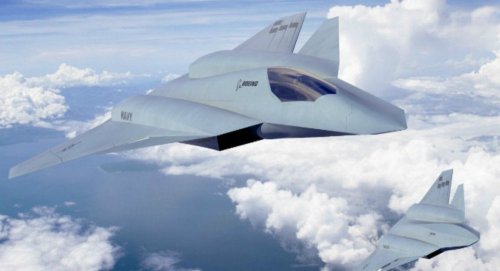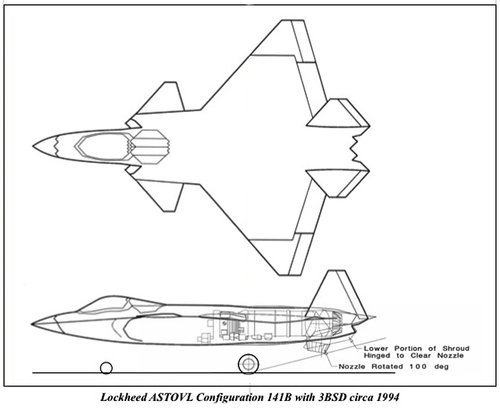aircraft designed to avoid detection by low-frequency tracking radars. Led by Northrop Grumman B-21s
I dont think this is correct, unless B-21 looks completely different than the notional representation we have been shown.
aircraft designed to avoid detection by low-frequency tracking radars. Led by Northrop Grumman B-21s
The USN’s next-generation fighter won’t be jointly developed with the USAF. That’s because the USN does not plan to use its Next Generation Air Dominance (NGAD) aircraft on penetration missions in highly-contested air space as the USAF aims to do with its next-generation fighter, says Angie Knappenberger, USN deputy director of air warfare, at the Navy League Sea-Air-Space conference in National Harbor, Maryland.

They could have gone ahead with UCLASS if they wanted that. Even with such an aircraft they should have something with high performance for the defense of the carrier battle group, air-to-air combat, interception, etc.Also, based on the statement that the Navy isn't looking for the same kind of plane the USAF is, I'm betting the Navy is planning to go unmanned and/or something with more persistence than range; i.e., something that cruises at subsonic speeds, versus supercruise.
Based on the nose gear in those pics, and what appears to be a wing fold section, it appears to be a design for the Navy. It's also interesting in that the nose is similar to the original YF-23 design. Now they need to release good drawings with cross sections so I can model this in flight simulator.
Also, based on the statement that the Navy isn't looking for the same kind of plane the USAF is, I'm betting the Navy is planning to go unmanned and/or something with more persistence than range; i.e., something that cruises at subsonic speeds, versus supercruise.

Based on the nose gear in those pics, and what appears to be a wing fold section, it appears to be a design for the Navy. It's also interesting in that the nose is similar to the original YF-23 design. Now they need to release good drawings with cross sections so I can model this in flight simulator.
Also, based on the statement that the Navy isn't looking for the same kind of plane the USAF is, I'm betting the Navy is planning to go unmanned and/or something with more persistence than range; i.e., something that cruises at subsonic speeds, versus supercruise.
The carrier mafia should watch out as they may just talk themselves out a mission/job. If one can't assist SEAD from day one and can't play till after day 20 or more, what value do you (carrier aircraft) provide?
“A penetrating fighter, the Navy doesn’t have to do that. So some of that inherent design of the aircraft it does drive costs and if you don’t need that for our mission area then you don’t necessarily want to pay for it,” she says, noting the shape of a highly stealthy penetrating fighter, presumably without a vertical stabliser, would be more expensive to develop.
Instead, the USN would conduct penetrating airstrikes against an advanced adversary with long-range standoff missiles or the mission would be deferred to the USAF, says Knappenberger.
Depending on expensive long range standoff missiles from ships w/ limited magazines to accomplis SEAD is pretty questionalble bet IMHO. IADS are mobile and will themselves be protected w/ terminal intercept defenses. USN will need to be using their magazines to protect themselves, little room left JSEAD. Better a capable carrier aircraft in common w/ the USAF. Carring drones, maybe a big gun, a deep mag DEW etc. Something the DOD gets economy of scale in large sophisticated and expensive craft. No more lacking capability fighters please.The carrier mafia should watch out as they may just talk themselves out a mission/job. If one can't assist SEAD from day one and can't play till after day 20 or more, what value do you (carrier aircraft) provide?
Remarkably little value which, incredibly, they do acknowledge.
“A penetrating fighter, the Navy doesn’t have to do that. So some of that inherent design of the aircraft it does drive costs and if you don’t need that for our mission area then you don’t necessarily want to pay for it,” she says, noting the shape of a highly stealthy penetrating fighter, presumably without a vertical stabliser, would be more expensive to develop.
Instead, the USN would conduct penetrating airstrikes against an advanced adversary with long-range standoff missiles or the mission would be deferred to the USAF, says Knappenberger.
My emphasis.


Roper Calls For New Air Force Planes Every Five Years; Recalls X Plane Days - Breaking Defense
PARIS AIR SHOW: During an unusual public appearance in the US Chalet, Will Roper called for a large expansion in the number of companies doing business with the Air Force so more new planes can be built — and be built much more quickly as was done in the 1950s and ’60s when a new…breakingdefense.com
I'm quite sure that the defense establishment won't say "no" if the DoD gives them a couple of billions each year with no questions asked other than to play around with new designs.
Roper Calls For New Air Force Planes Every Five Years; Recalls X Plane Days - Breaking Defense
PARIS AIR SHOW: During an unusual public appearance in the US Chalet, Will Roper called for a large expansion in the number of companies doing business with the Air Force so more new planes can be built — and be built much more quickly as was done in the 1950s and ’60s when a new…breakingdefense.com
I'm quite sure that the defense establishment won't say "no" if the DoD gives them a couple of billions each year with no questions asked other than to play around with new designs.
Roper Calls For New Air Force Planes Every Five Years; Recalls X Plane Days - Breaking Defense
PARIS AIR SHOW: During an unusual public appearance in the US Chalet, Will Roper called for a large expansion in the number of companies doing business with the Air Force so more new planes can be built — and be built much more quickly as was done in the 1950s and ’60s when a new…breakingdefense.com
3. Ensure that the small program benefited from the larger's need.
#3 is an important one. Do you think that the F-35B/C would have happened (in their entirety) if it were not for the largest customer, the F-35A, being part of the deal?
As far as I know without the C variant the whole airframe layout would have been much different anyway so I don't think you can make a direct comparison about weight like that.NATF & A-12v2 were "small" in that they were single-service, single-use airframes both destined for a service where all must bow to the Gods of the Flattops.
Without the C then the A would have only had a 1k bomb bay instead of 2k, the B would not have had SWAT, and both the A & B would have ended up heavier than they did.
In a "common avionics & engine" scenario, the C would still be limited to the performance of the F135 so I am not sure of what benefit separate programs would have been. In either case, costs would have only gone up as most development would have to be duplicated and parts economy of scale goes out the window for anything not avionics or engine related.

If the replacement for the Air Force's F-16 had not been part of a joint program would its attributes be different? The design points for internal weapon load weights, the capability for super cruise, unrefueled range and radar cross section. Think there were a lot of trades to create the JAST/JSF aircraft. Not saying it would have been better but it would certainly have been different. Have wondered if the McDonnell Douglas JAST proposal had been a CTOL only design would it have been a very stealthy super cruising strike aircraft?
If the replacement for the Air Force's F-16 had not been part of a joint program would its attributes be different? The design points for internal weapon load weights, the capability for super cruise, unrefueled range and radar cross section. Think there were a lot of trades to create the JAST/JSF aircraft. Not saying it would have been better but it would certainly have been different. Have wondered if the McDonnell Douglas JAST proposal had been a CTOL only design would it have been a very stealthy super cruising strike aircraft?
The only F-16 replacement "pre JAST" program that I know of is "Multi-Role Fighter (MRF) 1990-1993"
Multi-Role Fighter (MRF) 1990-1993
www.globalsecurity.org
They were stealthy bu not so sure on super-cruise ability.
Just that it would be clear to all, "slenderness" has nothing to do with max speed and drag. The X-3 is "slender" but didn't go as fast has the X-1E that has a bulky fuselage.
Just that it would be clear to all, "slenderness" has nothing to do with max speed and drag. The X-3 is "slender" but didn't go as fast has the X-1E that has a bulky fuselage.
One of the fastest plane down low over Europe was the Buccaneer that isn't really "slender".
The bulky Orbiter was one of fastest winged aircraft to fly...
Efficiency comes in many way. There are no one single solution to all problem. And one thing that we can say is that the 35 is Uber efficient.
The bulky Orbiter was one of fastest winged aircraft to fly...
